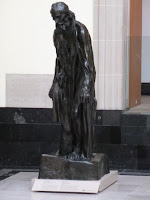Enroute to the Chagall exhibit were wall hangings by Inuit artist Irene Avaalasqiaq (I've always wondered why there are so many a's in Inuit names). Her quilts display whimsical images and titles including one called "Tarzan and Jane on TV with Interference", possibly inspired by a real life experience?
One of our favourite exhibits was "Constructing Utopia" showing in the Walter Trier Gallery. It was a collection of Russian propaganda books and posters from revolutionary Russia (1910-1940). Many of the posters were drawn with black and red ink since these were most easily accessible during the years of war and austerity. Major themes of the posters dealt with labour, industry and education. Translated slogans touted propaganda statements such as "Only Russian Rule leads the masses to light and education" and "Peasant Women, read your newspapers!". Visual propaganda was directed at the less educated lower class through strong heroic images of industry workers, revolutionary soldiers and party members.
 Russian artist Kazimir Malevich's cartoonish images drawn during WWI, depict farmers and village people triumphing over German soldiers. The intent was obviously to spur on the common folk to acts of patriotism, similar to the American Uncle Sam posters from the same time period.
Russian artist Kazimir Malevich's cartoonish images drawn during WWI, depict farmers and village people triumphing over German soldiers. The intent was obviously to spur on the common folk to acts of patriotism, similar to the American Uncle Sam posters from the same time period.The most striking and iconic poster in the exhibit is the one by Adolf Strakhov marking the death of Lenin in 1924. It shows Lenin dressed in bright revolutionary red, standing in front of factories that symbolize the desire for progress and industry. His stance and the trucks of armed civilians in the background conveyed the following message - An armed revolution under the leadership of Lenin would spur the Russian people to move forward toward industrial progress and prosperity.
An interesting corollary to the theme of factories, industry and progress arose in the next exhibit "Songs of the Future: Canadian Industrial Photos". There was a fascinating video interview with photographer George Hunt who described how public opinion on his photos of billowing smokestacks seemingly changed overnight. What was initially seen as positive advertising for a booming, thriving economy suddenly become taboo once the environmentalists took their stance. Suddenly companies no longer wanted their factories or buildings portrayed in this fashion as they were now painted as greedy corporate sharks who didn't care about the planet.
The Grange Prize for Photography is awarded for the best in contemporary photography from Canada and a partnering international country which rotates each year. Two Canadian photographers and two from the partnering country are selected for the shortlist, from which the public can place votes to select the winner. This year the country is India.
The photos from all four photographers were vibrant and interesting so it was difficult to choose. The work from the two Indian photographers (Nandini Valli and Gauri Gill) seemed foreign and exotic as they gave insight into life in India. Elaine Stocki from Manitoba displays photos related to race and class in North America. Althea Thauberger from Vancouver has an eclectic group of photos, but the ones that stand out are her shots of women soldiers in Afghanistan. It was jarring to see photos of women who looked like every day housewives decked out in military gear and holding huge guns.
The Isadore and Rosalie Sharp Gallery on the first floor was featuring a set of Toulouse Lautrec and 1960s Rock and Roll posters that were a recent donation from a New York collector. The juxtaposition of art from such different eras made for interesting viewing.
The exhibit "From Renaissance to Rodin" represented an even greater collection of donated art from benefactors Joey and Toby Tannenbaum. An entire gallery was filled with huge Renaissance paintings and sculptures, including one called "Expulsion of the Money-Changers" and highlighted by Bernini's amazing marble bust of Pope Gregory XV. A vivacious Joey Tannenbaum recorded a video describing how he came across the sculpture in an auction. It was only "attributed to Bernini" and therefore was selling at a very reasonable price. Somehow he knew instinctively that it was a real Bernini and instructed his agent to buy it under the agent's name, so as not to attract attention.
Another story he told was about how he acquired the two magnificent Rodin sculptures called "Burghers of Calais" which are currently on display in the Walker's Court. He talks about how he was first brought on a school trip to the Art Gallery of Toronto (as it was then called) at age 8 and fell in love at first sight with a Rodin sculpture. He claims that he vowed he would have one of his own one day, and fulfilled this promise by donating two to the AGO. It is inspiring to imagine the maturity and foresight of this little boy to recognize the beauty of a Rodin at that age!
These particular sculptures depict a heart-wrenching time in history. During the Hundred Years War in 1347, King Edward III occupied the French port of Calais and was starving its people with a blockade. He offered to spare the inhabitants if the leaders of the town would offer themselves up for surrender and execution. The two statues give tribute to two of the heroic men who sacrificed themselves for their people - Eustache de Saint Pierre & Andrieux d'Andres. I found a fascinating article about the sculptures at this link.
So although we did not get to see the blockbuster Chagall show we headed out for, a trip to the AGO is never wasted and we ended up experiencing a slue of diverse exhibits.










No comments:
Post a Comment